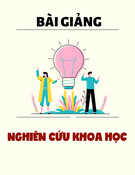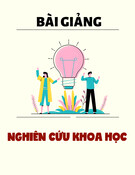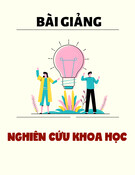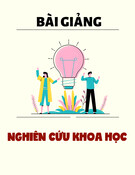
TẠP CHÍ KHOA HỌC QUẢN LÝ GIÁO DỤC SỐ 01(45), THÁNG 3 – 2025
111
VẬN DỤNG PHƯƠNG PHÁP PECS KẾT HỢP VỚI TRÒ CHƠI ĐỂ
LUYỆN PHÁT ÂM CHO TRẺ 3 – 4 TUỔI CÓ RỐI LOẠN PHỔ TỰ KỈ
APPLYING THE PECS METHOD IN COMBINATION WITH GAMES TO PRACTICE
PRONUNCIATION FOR 3-4-YEAR-OLD CHILDREN WITH AUTISM SPECTRUM DISORDER
PHAN THỊ HẰNG*, NGUYỄN THỊ HOÀI THU** , DƯ THỐNG NHẤT***,
nhatdt@hcmue.edu.vn
* Khoa Giáo dục Đặc biệt, trường Đại học Sư phạm TP. Hồ Chí Minh
** Trường Mầm non Hòa Nhập Hướng Dương, TP. Thủ Đức
*** Khoa khoa học giáo dục, trường Đại học Sư phạm TP. Hồ Chí Minh.
THÔNG TIN
TÓM TẮT
Ngày nhận: 17/02/2025
Ngày nhận lại: 15/03/2025
Duyệt đăng: 18/03/2025
Mã số: TCKH-S01T03-2025-B12
ISSN: 2354 - 0788
Bài viết trình bày kết quả vận dụng phương pháp PECS kết hợp trò
chơi để luyện phát âm cho trẻ 3 - 4 tuổi có rối loạn phổ tự kỉ tại trường
mầm non hoà nhập. Phương pháp nghiên cứu chủ yếu được sử dụng
trong bài viết là phương pháp nghiên cứu định lượng nhằm xác định
khả năng phát âm của 4 trẻ có rối loạn phổ tự kỉ trước và sau khi tham
gia luyện phát âm kéo dài 1 tháng. Kết quả nghiên cứu cho thấy cả 4
trẻ đã có những tiến bộ đáng kể về mặt phát âm, thể hiện qua khả năng
tự phát âm đúng các từ một cách rõ ràng hơn, với mức độ phát âm cải
thiện từ mức độ 4 lên mức độ 3 theo thang đo đánh giá. Nghiên cứu
này khẳng định hiệu quả của việc kết hợp phương pháp PECS với trò
chơi trong việc luyện phát âm đối với trẻ rối loạn phổ tự kỉ. Việc kết
hợp này không chỉ giúp trẻ hứng thú hơn trong quá trình học tập mà
còn góp phần nâng cao đáng kể khả năng phát âm, giúp trẻ phát âm
rõ ràng, trôi chảy và dễ dàng hơn trong giao tiếp với bạn bè. Phương
pháp PECS kết hợp trò chơi giáo dục nên được tích hợp vào giáo dục
mầm non, đào tạo giáo viên và hỗ trợ cha mẹ học sinh. Nghiên cứu
tiếp theo cần mở rộng quy mô, theo dõi tác động dài hạn, tối ưu hóa
trò chơi và so sánh với phương pháp truyền thống.
Từ khóa:
Luyện phát âm, rối loạn phổ tự kỉ,
giáo dục hoà nhập, trò chơi học
tập.
Keywords:
Pronunciation training, autism
spectrum disorder, inclusive
education, educational games.
ABSTRACT
This article presents the results of applying the Picture Exchange
Communication System (PECS) method in combination with
games to practice pronunciation for 3–4-year-old children with
autism spectrum disorder at an inclusive preschool. The main
research method utilized in this study is the quantitative research
method, aiming to determine the pronunciation capabilities of four
children with autism spectrum disorder before and after
participating in one month of pronunciation training. The research
results indicate that all four children showed significant progress
in pronunciation, as evidenced by their ability to independently
articulate words more clearly, with their pronunciation level
improving from level 4 to level 3 based on the evaluation scale.
This study underscores the effectiveness of combining the PECS
method with games in pronunciation training for children with
autism spectrum disorder. This integration not only enhances the
children’s interest in the learning process but also significantly
contributes to improving their pronunciation ability, enabling them
to articulate clearly, fluently, and more easily engage in
communication with peers. The PECS method combined with
educational games should be integrated into early childhood

PHAN THỊ HẰNG - NGUYỄN THỊ HOÀI THU - DƯ THỐNG NHẤT
112
education, teacher training, and parental support. Future research
should expand in scale, assess long-term effects, optimize games,
and compare with traditional methods.
1. Introduction
Autism Spectrum Disorder (ASD) has been
a subject of interest and research among
scientists since the 1940s. In 1943, American
psychiatrist Leo Kanner provided specific
descriptions of autism and children with ASD
(Le Minh Cong and Ngo Xuan Diep, 2012).
ASD is characterized by deficits in social
communication and a preference for repetitive,
stereotyped behaviors, which consequently lead
to delays in children’s language development
(Vu Thi Thuy Dung, Nguyen Thi Tan, Do Thi
Hao, 2024). ASD is a developmental disability
that persists throughout life, often appearing
within the first three years of life. Key
characteristics of ASD include impairments in
social interaction, verbal, and non-verbal
communication. Most children with ASD face
significant challenges in verbal expression
compared to typically developing children.
Additionally, these children often exhibit restricted
interests and repetitive, unchanging activities over
time (Nguyen Xuan Hai, 2010). Research findings
on 15 children with ASD in Hanoi indicate that all
three-year-old children had spoken language, and
their vocabulary size increased annually.
However, the rate of language development varied
among children, depending on the severity of the
disorder and the language training they received
(Nguyen Thi Giang, 2024).
Speech therapy for children with ASD aged
3 to 4 is crucial for fostering language
development and improving communication
skills. Gameplay serves as an effective method,
as it not only captivates children’s interest but
also enhances their overall learning experience.
Given the challenges children with Autism
Spectrum Disorder (ASD) face in pronunciation
and social interaction, integrating the PECS
method with educational games creates a
structured yet engaging environment that
promotes active participation and builds
confidence in speech practice. This approach
strengthens both language acquisition and social
integration, making it a valuable tool in early
intervention. Research on play activities in
preschoolers has affirmed that play is a
fundamental aspect of early childhood and
serves as the primary means of learning at this
stage (Nguyen Thi Hoa, 2011). Young children
naturally acquire knowledge through play, yet
those with ASD often engage in solitary or
observational play and rarely participate in
cooperative activities with peers. Therefore,
incorporating structured play-based
interventions not only fosters social interaction
but also provides educators with opportunities to
encourage more natural, enthusiastic, and
effective verbal expression in children with
ASD. As inclusive education continues to gain
importance, applying this method can
significantly enhance early intervention efforts
and provide a strong foundation for children’s
long-term development.
According to the Law on Persons with
Disabilities, the “rights and responsibilities of
persons with disabilities are the obligations of the
state, family, and society” (National Assembly of
the Socialist Republic of Vietnam, 2010). Children
with Autism Spectrum Disorder (ASD) also have
the right to study, dream, play, and engage in
activities like their peers. Inclusive education (IE)
is defined as “an educational approach for all
children, including those with special educational
needs, within regular classrooms of mainstream
schools” (Nguyen Xuan Hai, Le Thi Thuy Hang,
Tran Thi Thiep, 2008, p. 15). This is an inevitable
trend adopted by most countries worldwide to
ensure the fundamental rights of all children, as
stated in the International Convention on the
Rights of the Child. In inclusive preschools,
children with ASD often face difficulties in
playing and interacting with their classmates.
The role of teachers in organizing activities to
encourage children with ASD to integrate into
peer groups, imitate, and learn from their peers
is extremely important. However, current IE
practices reveal that training speech
development for children with ASD through
play activities has not been adequately
prioritized. Many classroom play activities
remain generic and lack specific goals tailored
for children with ASD, failing to address their
individual characteristics such as tendencies to
play alone, limited sharing or communication
with peers, disputes over toys, mechanical or
stereotyped play, minimal use of verbal
communication while playing, or a tendency to
distance themselves and display indifference
toward others (Dao Thi Thu Thuy, 2016). Children
with ASD need appropriate support while
participating in play activities to help them
communicate more effectively and gradually
integrate with their peers. Developing methods to
organize play activities suitable to the
developmental characteristics of these children not

TẠP CHÍ KHOA HỌC QUẢN LÝ GIÁO DỤC SỐ 01(45), THÁNG 3 – 2025
113
only enhances their engagement but also creates an
enabling environment for natural language
development and social skills acquisition.
In 2014, the National Professional
Development Center on Autism Spectrum
Disorders (NPDC) in the United States
recognized the Picture Exchange Communication
System (PECS) as one of 27 evidence-based
educational intervention methods for children
with autism spectrum disorders (ASD) (Vu Thi
Thuy Dung et al., 2024). Numerous studies
globally have confirmed the role of PECS in
supporting communication for children with ASD.
Researchers such as Ganz and Simpson (2004)
conducted studies analyzing the practical
application of this method. In Vietnam, there are
a few studies related to the use of PECS in
vocabulary development for children with ASD,
such as: “The Status of Using PECS Card Systems
in Language Therapy for Children with Autism in
Hanoi” (Nguyen Thieu Da Huong, 2015) and
“Applying the PECS Method to Develop
Vocabulary for 3-4-Year-Old Children with Autism
Spectrum Disorders at the Special Em’s Education
Center” (Vu Thi Thuy Dung et al., 2024, p. 236).
However, there is a lack of studies detailing how
to combine the PECS method with games to
improve pronunciation for children with ASD.
This combination not only helps enhance
children’s pronunciation abilities but also
creates opportunities for them to participate in
group activities in an enthusiastic, flexible
manner while being tailored to their individual
characteristics. As such, researching and
experimenting with the integration of PECS and
games may open a more effective approach to
supporting children with ASD in developing
language and social communication skills. This
study presents experimental results on the
application of the PECS method combined with
games to practice pronunciation for 3-4-year-old
children with ASD at Huong Duong
Kindergarten, Thu Duc City. Through this, the
research assesses the effectiveness of this
method in improving pronunciation skills and
enhancing communication abilities in children
with ASD, contributing to proposing suitable
intervention solutions in inclusive education.
2. Literature Review
2.1. Practicing Pronunciation for 3-4-Year-Old
Children with ASD Through the PECS Method
Combined with Educational Games
2.1.1. Practicing Pronunciation for 3-4-Year-
Old Children with ASD
Practicing pronunciation for children
involves guiding them to accurately articulate
the sounds of their native language, enabling
them to pronounce words clearly and correctly
according to phonetic rules. Additionally,
children are trained in adjusting their voice to be
expressive and suitable for different
communication contexts, which includes
modulating voice intensity (loud or soft), speech
tempo (fast or slow), rhythm (pausing
appropriately), and conveying emotional
nuances in speech (Vo Thi Dieu Hong, 2023).
Furthermore, practicing pronunciation not only
enhances children’s listening abilities but also
supports the flexible coordination of speech
organs such as lips, tongue, palate, and jaw,
thereby helping them develop precise articulation
skills (Nguyen Thi Phuong Nga, 2006). For
children aged 3-4 years with ASD, learning
pronunciation poses greater challenges
compared to typically developing children due
to limitations in communication skills, language
cognition, and motor coordination abilities. The
process of pronunciation practice requires
patience and adjustments tailored to each child
based on the severity of their disorder. Initially,
children should be guided to correctly
pronounce words containing basic sounds,
gradually increasing complexity to compound
words or short phrases. Once children can
accurately articulate some individual words,
they should be encouraged to use simple
vocabulary in daily communication to enhance
their language abilities, while also creating a
natural communication environment for regular
practice. Repeated pronunciation exercises
incorporated into contexts of play and
interaction can enable children to acquire
language more effectively, thereby improving
communication skills and social integration
(Phan Thi Hang, Nguyen Thi Hue, 2024).
In this study, we focus on training children
aged 3-4 years with ASD to clearly and accurately
pronounce individual words. We will assess the
ability to pronounce correctly 30 words from the
theme “Self,” which includes basic sounds such as
b, p, t, k, m. These sounds are selected for their
simplicity and ease of articulation for children in
this age group, as well as for their potential to
evaluate the level of control over speech organs
such as lips, tongue, palate, and jaw. The choice of
the theme “Self” is not only appropriate for the
children’s cognitive capabilities but also enables
them to relate to familiar objects and events from
daily life. According to Dinh Hong Thai (2008),
organizing words into specific thematic categories
aids children in systematizing the acquisition and
retention of language, thereby improving their
pronunciation and communication skills naturally.
During the experimental process, we will observe

PHAN THỊ HẰNG - NGUYỄN THỊ HOÀI THU - DƯ THỐNG NHẤT
114
and document the accuracy of each child’s
pronunciation for individual words, as well as
assess their ability to adjust their pronunciation
following guidance. The findings of this research
will contribute toward proposing effective
pronunciation practice methods designed to support
children with ASD in enhancing their pronunciation
and communication skills more efficiently.
Table 1. 30 words containing basic sounds within the theme “Self”
(Source: The authors (compiled))
Levels for evaluating children’s ability to
pronounce correctly according to Dinh Hong
Thai (2008): Level 1: children pronounce
correctly 24 - 30 words; Level 2: children
pronounce correctly 17 - 23 words; Level 3:
children pronounce correctly 8 - 16 words; Level
4: children pronounce correctly 7 - 0 words.
2.1.2. PECS Method
PECS is a communication system using
pictures, belonging to the group of augmentative
and alternative communication (AAC) methods.
This method was developed in 1985 by
psychologist Andrew Bondy and speech-language
therapist Lori Frost within the Delaware Autism
Program (Vu Thi Thuy Dung et al., 2024). PECS
is designed to support individuals who face
difficulties in verbal communication,
particularly children with ASD, helping them
develop the ability to express needs, desires, and
ideas through pictures.
PECS users are taught how to exchange a
picture of an object or action they desire. According
to studies Flippin et al. (2010), this method not only
helps children develop communication skills but
also fosters the ability to initiate communication
(i.e., the ability to communicate spontaneously).
Additionally, PECS trains important social skills
such as approaching and interacting with others,
expressing needs and thoughts clearly through
selecting and distinguishing images.
According to results from the Delaware
Autism Program, up to 76% of children
applied with the PECS method began to use
speech and significantly improved their
communication skills. The outstanding
benefits of PECS in practicing pronunciation
and supporting communication for children
with ASD include:
- Encouraging active communication: PECS
helps children proactively initiate the exchange of
information through images to express needs,
desires, or ideas, thereby developing
communication skills in a more active and
effective manner (Flippin et al., 2010).
- Enhancing independence: PECS helps
children become independent in communication
by using pictures to express their desires,
reducing their dependence on adult assistance.
- Supporting comprehension and language
development: PECS aids children in learning to
associate words with real-world objects, thereby
enhancing their vocabulary and communication
skills (Ganz & Simpson, 2004).
- Aligning with learning characteristics of
children with ASD: Since children with ASD
tend to process information better through visual
means, PECS leverages this strength to make the
learning process more engaging and effective
(Ganz & Simpson, 2004; Flippin et al., 2010).
- Assisting with speech articulation practice:
When educators use a dynamic, clear, and
comprehensible picture communication system,
children are encouraged to articulate words
associated with the images, hence improving their
speech abilities.
PECS is divided into six stages, ranging
from simple to complex, designed to
systematically develop communication and
language skills (Vu Thi Thuy Dung at al., 2024):
Stage 1 - Picture exchange: Children learn
to use a picture to exchange with others in order
to receive the item they desire. The goal is to
help children proactively initiate independent
communication.
Stage 2 - Distance and persistence: Children
learn to bring the picture to another person to
effectively communicate, even when the
communication partner is not nearby.
Stage 3 - Picture discrimination: Children
learn to differentiate and select the correct
picture to express their desires, rather than
relying on a single recurring image.
No.
Sound “b”
No.
Sound “p”
No.
Sound “t”
No.
Sound “m”
No.
Sound “k”
1
Bụng/Stomach
7
Phổi/Lungs
13
Tay/Hands
19
Mắt/Eyes
25
Kéo/Scissors
2
Bé/Child
8
Phao/Buoy
14
Tim/Heart
20
Môi/Lips
26
Khớp/Joints
3
Buồn/Sad
9
Phấn/Chalk
15
Tai/Ears
21
Má/Cheeks
27
Khóc/Crying
4
Bút/Pen
10
Phải/Right
16
Tóc/Hair
22
Mũi/Nose
28
Khăn/Towel
5
Bảng/Board
11
Phồng/Swollen
17
Trán/Forehead
23
Miệng/Mouth
29
Không/No
6
Balô/Backpack
12
Phim/Film
18
Thận/Kidneys
24
Mí/Eyelids
30
Kính/Glasses

TẠP CHÍ KHOA HỌC QUẢN LÝ GIÁO DỤC SỐ 01(45), THÁNG 3 – 2025
115
Stage 4 - Sentence structure: Children begin
to arrange pictures into a simple sentence, such as
a sentence starting with “I want...” accompanied
by an image of the desired object.
Stage 5 - Answering questions: Children
learn to use PECS to respond to questions, such as
“What do you want?”, enhancing their ability to
engage in two-way communication.
Stage 6 - Commenting: Children expand their
communication abilities from merely requesting
items to commenting on events, activities,
emotions, and personal thoughts.
Each stage of PECS is designed from
simple to complex, enabling users to develop
autonomy in communication and social
interaction.
In this study, we primarily apply the first
two stages of PECS (stages 1 and 2) in
combination with learning games to support 3-
4-year-old children with ASD in practicing
speech articulation. Before initiating articulation
practice, educators need to: 1) Clearly introduce
the pictures and how to use the cards; 2) Utilize
engaging games to encourage children to
interact and articulate words related to the
images; 3) Adjust the use of cards and the
organization of games to align with the
individual capabilities and needs of each child.
The integration of PECS with games not only
helps children practice pronunciation naturally but
also stimulates interest, enhances initiative, and
supports children in integrating into
communication activities. The results of this study
will contribute to providing a scientific foundation
for the application of the PECS method in
inclusive education and supporting language
development for children with ASD.
2.1.3. Games
Play is an activity where its motivation lies
in the process rather than the outcome. The
actions within play stimulate children to
continue playing and maintain their interest.
During play, relationships between humans and
nature as well as society are simulated, helping
children develop cognition and social skills.
Play brings children a joyful, enthusiastic, and
comfortable mental state, primarily satisfying
their need for play without aiming to produce
specific products (Dinh Van Vang, 2016).
Games are autonomous activities in which
children have the freedom to choose games,
playmates, and seek resources to execute their
play intentions. Children can also actively expand
the theme of the games in various directions,
applying existing knowledge and skills to solve
tasks within the games (Nguyen Thi Hoa, 2011).
Games for preschool children are considered a
form for developing independence and positive
thinking, as reflected in the following
characteristics: 1) Freedom, voluntariness, and
independence - Children actively participate in
games without being coerced; 2) Self-regulation
- Children can control and adjust the process of
playing based on their preferences; 3) Creativity
- Children are not confined to rigid templates and
can innovate in their style of play; 4) Socio-
emotional traits - Games allow children to
express emotions and develop relationships with
peers and their surroundings.
Games are categorized in various ways. In the
current preschool education curriculum, games are
typically divided into three main groups: 1)
Creative games: role-playing thematic games,
dramatization games, construction-assembly
games; 2) Games with fixed content and rules:
educational games and physical games; 3) Folk
games: traditional games of the nation.
In this study, we focus on educational
games to organize and guide children to play
with interest, thereby supporting accurate
pronunciation practice for children with ASD.
Educational games are a type of game with
clear educational objectives, wherein children
solve learning tasks in a lighthearted,
comfortable manner through play. When
participating in educational games, children
perceive intellectual tasks as enjoyable, free, and
voluntary play, helping them achieve learning
goals without feeling pressured. Educational
games are characterized by being organized by
adults, with a variety of content and gameplay
rules. Each educational game not only offers
entertainment but also helps children develop
cognitive skills. The cognitive tasks within these
games require children to actively engage their
intellect, enabling them to learn observation,
comparison, analysis, and information retention
skills. An effective educational game must
combine both cognitive and humorous elements
to capture children’s attention. The humorous
component makes children feel excited and
unafraid of challenges, encouraging them to
overcome difficulties within the game.
Educational games have a distinct structure
compared to ordinary games. According to
Nguyen Thi Hoa (2011), an educational game
must encompass three main components: 1)
Cognitive task - Children must perform a
specific task related to learning, such as
identifying sounds, correctly articulating
sounds, arranging words, or matching letters; 2)
Play actions - Children must carry out
interactive activities within the game, such as
matching cards, finding objects, or expressing


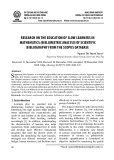
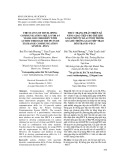


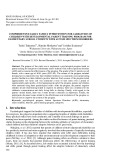

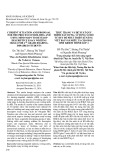












![Định hướng giáo dục STEM trong trường trung học: Tài liệu [chuẩn/mới nhất]](https://cdn.tailieu.vn/images/document/thumbnail/2025/20251124/dbui65015@gmail.com/135x160/25561764038505.jpg)
